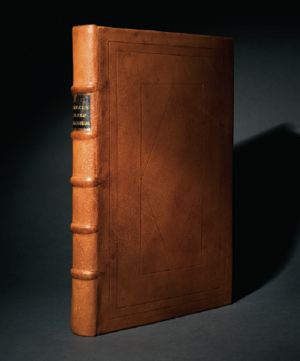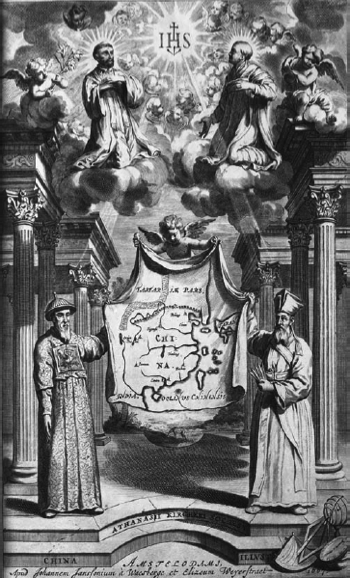|
||||||||||
|
NEW SCHOLARSHIPBinding Friendship: Ricci, China and Jesuit Cultural LearningsJeremy Clarke, SJ Boston College
This following is a report on an exhibition of rare books at the Burns Library, Boston College, Chestnut Hill, 21 March–31 October 2011.—The Editor  Fig.1 Confucius Sinarum Philosophus, Frs Intorcetta, Herdtrich, Rougemont and Couplet, 1687; rebound by Mark Esser As much as history is the result of actions deliberately taken or purposely avoided, so too can it also be the simple consequence of a number of random occurrences combining at the same time. The rare book exhibition currently on display at Boston College—'Binding Friendship: Ricci, China and Jesuit Cultural Learnings'—is both an instance of a lucky break and the culmination of a lot of quiet endeavour over many years. As reported in China Heritage Quarterly Issue 23 (September 2010), the focus of which was 'Matteo Ricci, after four hundred years', the past two years have been a busy time for those who study the life and effect of this famous Jesuit missionary to China. Conferences were held, films made and learned (and not so well informed) books written. The book exhibition, which features over fifty works from the Reverend J. Donal Monan, S.J. Collection of Jesuitana at Boston College, was at once an 'opportunistic' embrace of this commemorative fervor and a chance to make the most of years of good stewardship by librarians and archivists. The fortuitous Ricci anniversary provided a way to teach university students about east-west cultural exchange in the early modern period and offered a means to highlight a hitherto under-utilized resource. The books chosen for the exhibition (click here for a full list of the works on display) describe the cross-cultural aspects of the encounters between the European missionaries who went to China at the end of the sixteenth century and the Chinese who curiously welcomed the scientific knowledge that they brought with them. More than this, their presence at a Jesuit university in Chestnut Hill, Massachusetts, reveal the traditional value placed on scholarship by all who engage in the academic enterprise of preserving, remembering and evaluating anew. The exhibition consists of several main areas, including books that show the emphasis placed by the exploring missionaries on geography and mapping, works that explore the scientific knowledge transmitted during this time and biographies and studies about Matteo Ricci (including a first edition of his journal published in Augsburg, Germany in 1615).  Fig.2 Adam Schall and Matteo Ricci hold up a map of China as Francis Xavier and Ignatius Loyola look down from heaven, from China Monumentis, by Athanasius Kircher. (Photograph: William J. Donovan) Placing these books alongside each other in an exhibition of this sort allows a ready examination of the inter-connections that took place during this period of history. For instance, in the cabinet about the scientific exchange fostered by the Jesuit missionaries and their Chinese hosts and neophytes, a textbook on Aristotelian philosophy is on a stand next to two sixteenth-century mathematical textbooks by the famous Jesuit mathematician and astronomer Christopher Clavius (1538-1612), who was instrumental in the Gregorian reform of the calendar. (These are Euclidis Elementorum libri XV, compiled by Clavius and published in 1574; Gnomicies libri octo, by Christopher Clavius, published in 1581 and Commentarii Collegii Conimbricensis Societatis Iesv, put together by Jesuits at the Portuguese university at Coimbra in 1600). The content of the oldest of these three textbooks, the Elements of Euclid, would have been used to teach Matteo Ricci the deeper principles of mathematics while he was a student of Clavius at the new and influential Jesuit university, the Roman College. This knowledge, combined with the practical examples and calculations contained in the book on sundials, was definitely of great use to Ricci when he was in China and helped to establish his reputation as a wise man from the west. Both these books, and the philosophical treatises contained in the compilation used by Jesuit philosophy students doing their academic training in Portugal in the late sixteenth century, were later translated into Chinese. This translation project was one undertaken and supported by one of the three pillars of the early Chinese Catholic church, Paul Xu Guangqi (1562-1633). One of the major underlying pedagogical principles of the classes built around the creation and maintenance of the exhibition is the fact that the transmission of such knowledge clearly did not only go one way. That is, while the laws of Euclidean geometry were of great interest to Chinese mandarins, so too were European scholars and savants fascinated by the reports sent back by the China-based Jesuit missionaries. Several of the books on display contain descriptions of silk production in Zhejiang, the various uses of the tea plant, the central tenets of Chinese philosophy (which included translating Confucian classics into European languages for the first time) and descriptions of cities and villages spread throughout the empire. As visitors to the exhibit deduce, Ricci's arrival in China was thus a stimulus for much cultural learning for both the societies of European and China. Boston College was fortunate in procuring these books during the late twentieth-century, a body of work that well reflects the Jesuits' stewardship of such knowledge over a long period of time. One of the essays in the accompanying exhibition catalog [PDF] by Caitlin Cain traces the various stages of the development of this collection, and explains how it is that this fine group of rare works came to be preserved in the north-eastern corner of the US, which is admittedly a long way from China and from the European cities where these books were published. This exhibition has also served as a catalyst to further research on aspects of history covered by the books in the collection. Already some other scholarly institutions around the world, including the Catholic University of Leuven, have made sure to link their own schools to the resources now made available more widely by this event. Scholars in Australia can also explore some of the works in this collection by making use of the digitized versions of both Athanasius Kircher's China Illustrata (published in 1667) and an English translation of Jean-Baptiste Du Halde's A Description of the Empire of China and Chinese-Tartary (1738). It is hoped that further works from the collection will also be digitally preserved and added to the accompanying collection website. For further information, see: http://www.bc.edu/sites/bindingfriendship/Related material from China Heritage Quarterly:
|